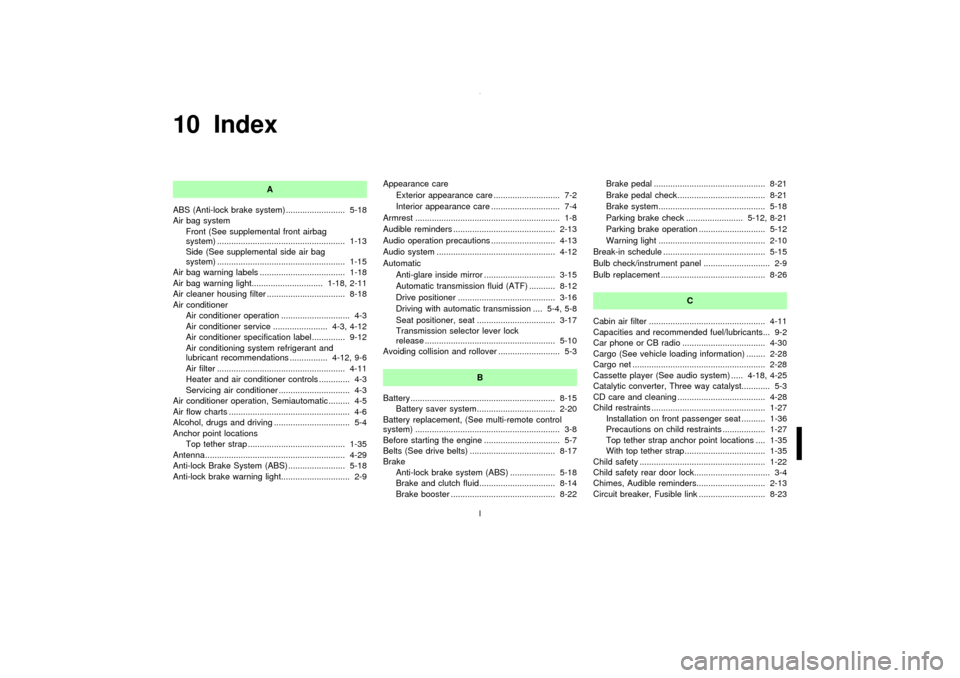service schedule NISSAN MAXIMA 2003 A33 / 5.G Owners Manual
[x] Cancel search | Manufacturer: NISSAN, Model Year: 2003, Model line: MAXIMA, Model: NISSAN MAXIMA 2003 A33 / 5.GPages: 247, PDF Size: 2.74 MB
Page 177 of 247

Your new NISSAN has been designed to have
minimum maintenance requirements with
longer service intervals to save you both time
and money. However, some day-to-day and
regular maintenance is essential to maintain
your NISSAN's good mechanical condition, as
well as its emission and engine performance.
It is the owner's responsibility to make sure
that scheduled maintenance, as well as gen-
eral maintenance, is performed.
As the vehicle owner, you are the only one
who can ensure that your vehicle receives the
proper maintenance care. You are a vital link
in the maintenance chain.
Scheduled maintenance:
For your convenience, both required and op-
tional scheduled maintenance items are de-
scribed and listed in your ªService and Main-
tenance Guideº. You must refer to that guide to
ensure that necessary maintenance is per-
formed on your NISSAN at regular intervals.
General maintenance:
General maintenance includes those items
which should be checked during normal day-
to-day operation of the vehicle. They are es-
sential if your vehicle is to continue to operate
properly. It is your responsibility to perform
these procedures regularly as prescribed.Performing general maintenance checks re-
quire minimal mechanical skill and only a few
general automotive tools.
These checks or inspections can be done by
yourself, a qualified technician or, if you prefer,
your NISSAN dealer.
Where to go for service:
If maintenance service is required or your
vehicle appears to malfunction, have the sys-
tems checked and tuned by an authorized
NISSAN dealer.
NISSAN technicians are well-trained special-
ists and are kept up to date with the latest
service information through technical bulletins,
service tips, and in-dealership training pro-
grams. They are completely qualified to work
on NISSAN vehiclesbeforethey work on your
vehicle, rather than after they have worked on
it.
You can be confident that your NISSAN deal-
er's service department performs the best job
to meet the maintenance requirements of your
vehicle Ð in a reliable and economic way.During the normal day-to-day operation of the
vehicle, general maintenance should be per-
formed regularly as prescribed in this section.
If you detect any unusual sounds, vibrations or
smell, be sure to check for the cause or have
your NISSAN dealer check it promptly. In
addition, you should notify your NISSAN
dealer if you think that repairs are required.
When performing any checks or maintenance
work, closely observe the ªMaintenance pre-
cautionsº later in this section.
EXPLANATION OF GENERAL
MAINTENANCE ITEMSAdditional information on the following
items with ª*º is found later in this section.Outside the vehicleThe maintenance items listed here should be
performed from time to time, unless otherwise
specified.
Tires*:Check the pressure with a gauge at
least once a month and always prior to long
distance trips. If necessary, adjust the pres-
sure in all tires, including the spare, to the
pressure specified. Check carefully for dam-
age, cuts or excessive wear.
Wheel nuts*:When checking the tires, make
sure no nuts are missing, and check for any
MAINTENANCE REQUIREMENTS GENERAL MAINTENANCE8-2
Maintenance and do-it-yourself
Z
02.7.12/A33-D/V5.0
X
Page 233 of 247

trailer is hitched. Do not drive the vehicle if
it has an abnormal nose-up or nose-down
condition; check for improper tongue load,
overload, worn suspension or other pos-
sible causes of either condition.
IAlways secure items in the trailer to prevent
load shifts while driving.
IBe certain your rear view mirrors conform to
all federal, state or local regulations. If not,
install any mirrors required for towing be-
fore driving the vehicle.
Trailer towing tipsIn order to gain skill and an understanding of
the vehicle's behavior, you should practice
turning, stopping and backing up in an area
which is free from traffic. Steering stability, and
braking performance will be somewhat differ-
ent than under normal driving conditions.
IAlways secure items in the trailer to prevent
load shift while driving.
IAvoid abrupt starts, acceleration or stops.
IAvoid sharp turns or lane changes.
IAlways drive your vehicle at a moderate
speed.
IAlways block the wheels on both vehicle
and trailer when parking. Parking on aslope is not recommended; however, if you
must do so, and if your vehicle is equipped
with automatic transmission, first block the
wheels and apply the parking brake, and
then move the transmission selector lever
into the P (Park) position. If you move the
selector lever to the P (Park) position be-
fore blocking the wheels and applying the
parking brake, transmission damage could
occur.
IWhen going down a hill, shift into a lower
gear and use the engine braking effect.
When ascending a long grade, downshift
the transmission to a lower gear and reduce
speed to reduce chances of engine over-
loading and/or overheating.
IIf the engine coolant rises to an extremely
high temperature when the air conditioning
system is on, turn off the air conditioner.
Coolant heat can be additionally vented by
opening the windows, switching the fan
control to high and setting the temperature
control to the HOT position.
ITrailer towing requires more fuel than nor-
mal circumstances.
IAvoid towing a trailer for the first 500 miles
(800 km).
IHave your vehicle serviced more often thanat intervals specified in the recommended
maintenance schedule.
IWhen making a turn, your trailer wheels will
be closer to the inside of the turn than your
vehicle wheels. To compensate for this,
make a larger than normal turning radius
during the turn.
ICrosswinds and rough roads will adversely
affect vehicle/trailer handling, possibly
causing vehicle sway. When being passed
by larger vehicles, be prepared for possible
changes in crosswinds that could affect
vehicle handling. If swaying does occur,
firmly grip the steering wheel, steer straight
ahead, and immediately (but gradually) re-
duce vehicle speed. This combination will
help stabilize the vehicle. Never increase
speed.
IBe careful when passing other vehicles.
Passing while towing a trailer requires con-
siderably more distance than normal pass-
ing. Remember the length of the trailer
must also pass the other vehicle before you
can safely change lanes.
ITo maintain engine braking efficiency and
electrical charging performance, do not use
fifth gear (manual transmission) or over-
drive (automatic transmission).9-18
Technical and consumer information
Z
02.7.12/A33-D/V5.0
X
Page 240 of 247

10 Index
A
ABS (Anti-lock brake system) ......................... 5-18
Air bag system
Front (See supplemental front airbag
system) ...................................................... 1-13
Side (See supplemental side air bag
system) ...................................................... 1-15
Air bag warning labels .................................... 1-18
Air bag warning light.............................. 1-18, 2-11
Air cleaner housing filter ................................. 8-18
Air conditioner
Air conditioner operation ............................. 4-3
Air conditioner service ....................... 4-3, 4-12
Air conditioner specification label.............. 9-12
Air conditioning system refrigerant and
lubricant recommendations ................ 4-12, 9-6
Air filter ...................................................... 4-11
Heater and air conditioner controls ............. 4-3
Servicing air conditioner .............................. 4-3
Air conditioner operation, Semiautomatic ......... 4-5
Air flow charts ................................................... 4-6
Alcohol, drugs and driving ................................ 5-4
Anchor point locations
Top tether strap ......................................... 1-35
Antenna........................................................... 4-29
Anti-lock Brake System (ABS) ........................ 5-18
Anti-lock brake warning light............................. 2-9Appearance care
Exterior appearance care ............................ 7-2
Interior appearance care ............................. 7-4
Armrest ............................................................. 1-8
Audible reminders ........................................... 2-13
Audio operation precautions ........................... 4-13
Audio system .................................................. 4-12
Automatic
Anti-glare inside mirror .............................. 3-15
Automatic transmission fluid (ATF) ........... 8-12
Drive positioner ......................................... 3-16
Driving with automatic transmission .... 5-4, 5-8
Seat positioner, seat ................................. 3-17
Transmission selector lever lock
release ....................................................... 5-10
Avoiding collision and rollover .......................... 5-3
B
Battery............................................................. 8-15
Battery saver system................................. 2-20
Battery replacement, (See multi-remote control
system) ............................................................. 3-8
Before starting the engine ................................ 5-7
Belts (See drive belts) .................................... 8-17
Brake
Anti-lock brake system (ABS) ................... 5-18
Brake and clutch fluid................................ 8-14
Brake booster ............................................ 8-22Brake pedal ............................................... 8-21
Brake pedal check..................................... 8-21
Brake system............................................. 5-18
Parking brake check ........................ 5-12, 8-21
Parking brake operation ............................ 5-12
Warning light ............................................. 2-10
Break-in schedule ........................................... 5-15
Bulb check/instrument panel ............................ 2-9
Bulb replacement ............................................ 8-26
C
Cabin air filter ................................................. 4-11
Capacities and recommended fuel/lubricants... 9-2
Car phone or CB radio ................................... 4-30
Cargo (See vehicle loading information) ........ 2-28
Cargo net ........................................................ 2-28
Cassette player (See audio system) ..... 4-18, 4-25
Catalytic converter, Three way catalyst............ 5-3
CD care and cleaning ..................................... 4-28
Child restraints ................................................ 1-27
Installation on front passenger seat .......... 1-36
Precautions on child restraints .................. 1-27
Top tether strap anchor point locations .... 1-35
With top tether strap.................................. 1-35
Child safety ..................................................... 1-22
Child safety rear door lock................................ 3-4
Chimes, Audible reminders............................. 2-13
Circuit breaker, Fusible link ............................ 8-23
Z
02.7.12/A33-D/V5.0
X